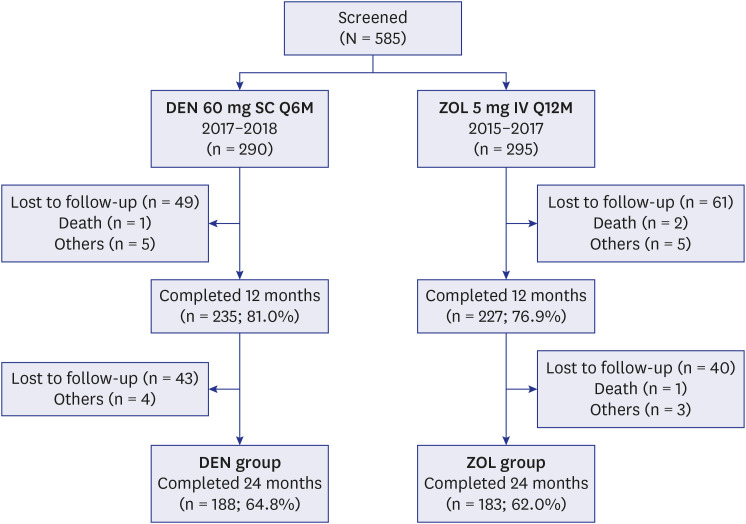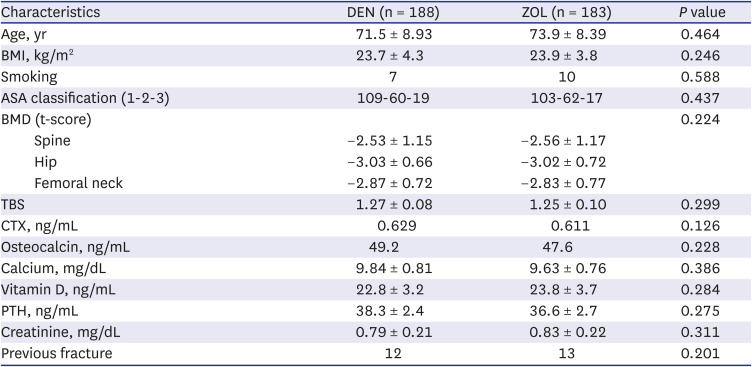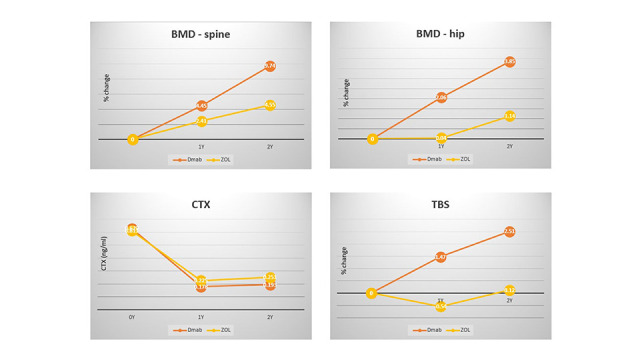1. NIH consensus development panel on osteoporosis prevention, diagnosis, and therapy, March 7-29, 2000: highlights of the conference. South Med J. 2001; 94(6):569–573. PMID:
11440324.
2. Black DM, Delmas PD, Eastell R, Reid IR, Boonen S, Cauley JA, et al. Once-yearly zoledronic acid for treatment of postmenopausal osteoporosis. N Engl J Med. 2007; 356(18):1809–1822. PMID:
17476007.

3. Cummings SR, San Martin J, McClung MR, Siris ES, Eastell R, Reid IR, et al. Denosumab for prevention of fractures in postmenopausal women with osteoporosis. N Engl J Med. 2009; 361(8):756–765. PMID:
19671655.

4. McClung MR, Lewiecki EM, Cohen SB, Bolognese MA, Woodson GC, Moffett AH, et al. Denosumab in postmenopausal women with low bone mineral density. N Engl J Med. 2006; 354(8):821–831. PMID:
16495394.

5. Tokeshi S, Eguchi Y, Suzuki M, Yamanaka H, Tamai H, Orita S, et al. Relationship between skeletal muscle mass, bone mineral density, and trabecular bone score in osteoporotic vertebral compression fractures. Asian Spine J. 2021; 15(3):365–372. PMID:
32872758.

6. Lee J, Chang G, Kang H, Ham DW, Lee JS, Jung HS, et al. Impact of bone mineral density on the incidence of age-related vertebral fragility fracture. J Korean Med Sci. 2020; 35(17):e116. PMID:
32356418.

7. Baron R, Ferrari S, Russell RG. Denosumab and bisphosphonates: different mechanisms of action and effects. Bone. 2011; 48(4):677–692. PMID:
21145999.

8. Bock O, Felsenberg D. Bisphosphonates in the management of postmenopausal osteoporosis--optimizing efficacy in clinical practice. Clin Interv Aging. 2008; 3(2):279–297. PMID:
18686751.
9. Lacey DL, Timms E, Tan HL, Kelley MJ, Dunstan CR, Burgess T, et al. Osteoprotegerin ligand is a cytokine that regulates osteoclast differentiation and activation. Cell. 1998; 93(2):165–176. PMID:
9568710.

10. Bone HG, Bolognese MA, Yuen CK, Kendler DL, Wang H, Liu Y, et al. Effects of denosumab on bone mineral density and bone turnover in postmenopausal women. J Clin Endocrinol Metab. 2008; 93(6):2149–2157. PMID:
18381571.

11. Majumdar S. A review of magnetic resonance (MR) imaging of trabecular bone micro-architecture: contribution to the prediction of biomechanical properties and fracture prevalence. Technol Health Care. 1998; 6(5-6):321–327. PMID:
10100935.

12. Pothuaud L, Barthe N, Krieg MA, Mehsen N, Carceller P, Hans D. Evaluation of the potential use of trabecular bone score to complement bone mineral density in the diagnosis of osteoporosis: a preliminary spine BMD-matched, case-control study. J Clin Densitom. 2009; 12(2):170–176. PMID:
19181553.

13. Pothuaud L, Carceller P, Hans D. Correlations between grey-level variations in 2D projection images (TBS) and 3D microarchitecture: applications in the study of human trabecular bone microarchitecture. Bone. 2008; 42(4):775–787. PMID:
18234577.

14. Winzenrieth R, Michelet F, Hans D. Three-dimensional (3D) microarchitecture correlations with 2D projection image gray-level variations assessed by trabecular bone score using high-resolution computed tomographic acquisitions: effects of resolution and noise. J Clin Densitom. 2013; 16(3):287–296. PMID:
22749406.

15. Hans D, Barthe N, Boutroy S, Pothuaud L, Winzenrieth R, Krieg MA. Correlations between trabecular bone score, measured using anteroposterior dual-energy X-ray absorptiometry acquisition, and 3-dimensional parameters of bone microarchitecture: an experimental study on human cadaver vertebrae. J Clin Densitom. 2011; 14(3):302–312. PMID:
21724435.

16. Silva BC, Leslie WD, Resch H, Lamy O, Lesnyak O, Binkley N, et al. Trabecular bone score: a noninvasive analytical method based upon the DXA image. J Bone Miner Res. 2014; 29(3):518–530. PMID:
24443324.

17. Kong SH, Hong N, Kim JW, Kim DY, Kim JH. Application of the trabecular bone score in clinical practice. J Bone Metab. 2021; 28(2):101–113. PMID:
34130362.

18. Krieg MA, Aubry-Rozier B, Hans D, Leslie WD. Manitoba Bone Density Program. Effects of anti-resorptive agents on trabecular bone score (TBS) in older women. Osteoporos Int. 2013; 24(3):1073–1078. PMID:
23052939.

19. Popp AW, Guler S, Lamy O, Senn C, Buffat H, Perrelet R, et al. Effects of zoledronate versus placebo on spine bone mineral density and microarchitecture assessed by the trabecular bone score in postmenopausal women with osteoporosis: a three-year study. J Bone Miner Res. 2013; 28(3):449–454. PMID:
23018784.

20. Hadji P, Claus V, Ziller V, Intorcia M, Kostev K, Steinle T. GRAND: the German retrospective cohort analysis on compliance and persistence and the associated risk of fractures in osteoporotic women treated with oral bisphosphonates. Osteoporos Int. 2012; 23(1):223–231. PMID:
21308365.

21. Siris ES, Selby PL, Saag KG, Borgström F, Herings RM, Silverman SL. Impact of osteoporosis treatment adherence on fracture rates in North America and Europe. Am J Med. 2009; 122(2):Suppl. S3–13.

22. Höer A, Seidlitz C, Gothe H, Schiffhorst G, Olson M, Hadji P, et al. Influence on persistence and adherence with oral bisphosphonates on fracture rates in osteoporosis. Patient Prefer Adherence. 2009; 3:25–30. PMID:
19936142.
23. Park CH, Jung KJ, Nho JH, Kim JH, Won SH, Chun DI, et al. Impact on bisphosphonate persistence and compliance: daily postprandial administration. J Bone Metab. 2019; 26(1):39–44. PMID:
30899723.

24. Silverman SL, Gold DT. Compliance and persistence with osteoporosis therapies. Curr Rheumatol Rep. 2008; 10(2):118–122. PMID:
18460266.

25. Huybrechts KF, Ishak KJ, Caro JJ. Assessment of compliance with osteoporosis treatment and its consequences in a managed care population. Bone. 2006; 38(6):922–928. PMID:
16330270.

26. Karlsson L, Lundkvist J, Psachoulia E, Intorcia M, Ström O. Persistence with denosumab and persistence with oral bisphosphonates for the treatment of postmenopausal osteoporosis: a retrospective, observational study, and a meta-analysis. Osteoporos Int. 2015; 26(10):2401–2411. PMID:
26282229.

27. Kobayashi K, Ando K, Machino M, Morozumi M, Kanbara S, Ito S, et al. Persistence of denosumab therapy among patients with osteoporosis. Asian Spine J. 2020; 14(4):453–458. PMID:
31940712.

28. Silverman SL, Siris E, Kendler DL, Belazi D, Brown JP, Gold DT, et al. Persistence at 12 months with denosumab in postmenopausal women with osteoporosis: interim results from a prospective observational study. Osteoporos Int. 2015; 26(1):361–372. PMID:
25236877.

29. Hans D, Goertzen AL, Krieg MA, Leslie WD. Bone microarchitecture assessed by TBS predicts osteoporotic fractures independent of bone density: the Manitoba study. J Bone Miner Res. 2011; 26(11):2762–2769. PMID:
21887701.

30. McClung MR, Lippuner K, Brandi ML, Zanchetta JR, Bone HG, Chapurlat R, et al. Effect of denosumab on trabecular bone score in postmenopausal women with osteoporosis. Osteoporos Int. 2017; 28(10):2967–2973. PMID:
28748386.

31. Senn C, Günther B, Popp AW, Perrelet R, Hans D, Lippuner K. Comparative effects of teriparatide and ibandronate on spine bone mineral density (BMD) and microarchitecture (TBS) in postmenopausal women with osteoporosis: a 2-year open-label study. Osteoporos Int. 2014; 25(7):1945–1951. PMID:
24760244.

32. Wu J, Zhang Q, Yan G, Jin X. Denosumab compared to bisphosphonates to treat postmenopausal osteoporosis: a meta-analysis. J Orthop Surg. 2018; 13(1):194.

33. Lyu H, Jundi B, Xu C, Tedeschi SK, Yoshida K, Zhao S, et al. Comparison of denosumab and bisphosphonates in patients with osteoporosis: a meta-analysis of randomized controlled trials. J Clin Endocrinol Metab. 2019; 104(5):1753–1765. PMID:
30535289.

34. Anastasilakis AD, Polyzos SA, Gkiomisi A, Saridakis ZG, Digkas D, Bisbinas I, et al. Denosumab versus zoledronic acid in patients previously treated with zoledronic acid. Osteoporos Int. 2015; 26(10):2521–2527. PMID:
25990355.

35. Miller PD, Pannacciulli N, Brown JP, Czerwinski E, Nedergaard BS, Bolognese MA, et al. Denosumab or zoledronic acid in postmenopausal women with osteoporosis previously treated with oral bisphosphonates. J Clin Endocrinol Metab. 2016; 101(8):3163–3170. PMID:
27270237.

36. Russell RG, Watts NB, Ebetino FH, Rogers MJ. Mechanisms of action of bisphosphonates: similarities and differences and their potential influence on clinical efficacy. Osteoporos Int. 2008; 19(6):733–759. PMID:
18214569.

37. Durden E, Pinto L, Lopez-Gonzalez L, Juneau P, Barron R. Two-year persistence and compliance with osteoporosis therapies among postmenopausal women in a commercially insured population in the United States. Arch Osteoporos. 2017; 12(1):22. PMID:
28243883.

38. Eliasaf A, Amitai A, Maram Edry M, Yosselson Superstine S, Rotman Pikielny P. Compliance, persistence, and preferences regarding osteoporosis treatment during active therapy or drug holiday. J Clin Pharmacol. 2016; 56(11):1416–1422. PMID:
26999526.

39. Ziller V, Kostev K, Kyvernitakis I, Boeckhoff J, Hadji P. Persistence and compliance of medications used in the treatment of osteoporosis--analysis using a large scale, representative, longitudinal German database. Int J Clin Pharmacol Ther. 2012; 50(5):315–322. PMID:
22541835.

40. Kendler DL, Macarios D, Lillestol MJ, Moffett A, Satram-Hoang S, Huang J, et al. Influence of patient perceptions and preferences for osteoporosis medication on adherence behavior in the Denosumab Adherence Preference Satisfaction study. Menopause. 2014; 21(1):25–32. PMID:
23676636.

41. Migliaccio S, Resmini G, Buffa A, Fornari R, Di Pietro G, Cerocchi I, et al. Evaluation of persistence and adherence to teriparatide treatment in patients affected by severe osteoporosis (PATT): a multicenter observational real life study. Clin Cases Miner Bone Metab. 2013; 10(1):56–60. PMID:
23858313.

42. Tremblay É, Perreault S, Dorais M. Persistence with denosumab and zoledronic acid among older women: a population-based cohort study. Arch Osteoporos. 2016; 11(1):30. PMID:
27679503.

43. Cheng LI, Durden E, Limone B, Radbill L, Juneau PL, Spangler L, et al. Persistance and compliance with osteroporosis therapies among women in a commercially insured population in the United States. J Manag Care Spec Pharm. 2015; 21(9):824–833. –833a. PMID:
26308229.









 PDF
PDF Citation
Citation Print
Print




 XML Download
XML Download